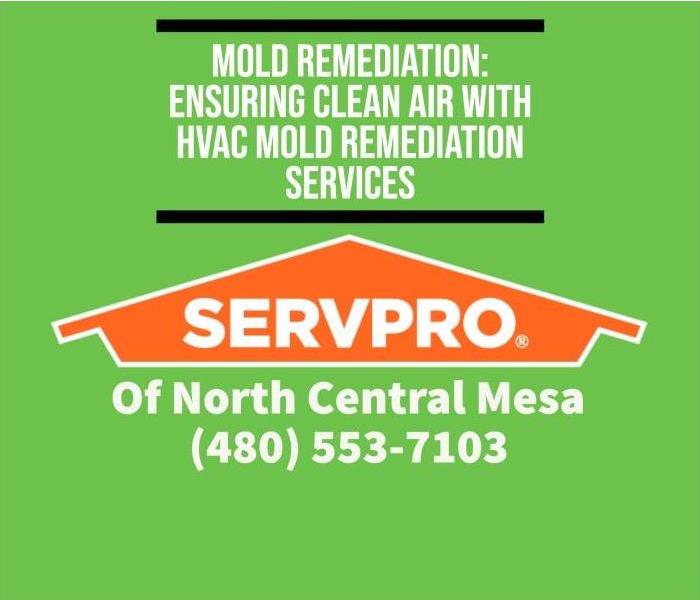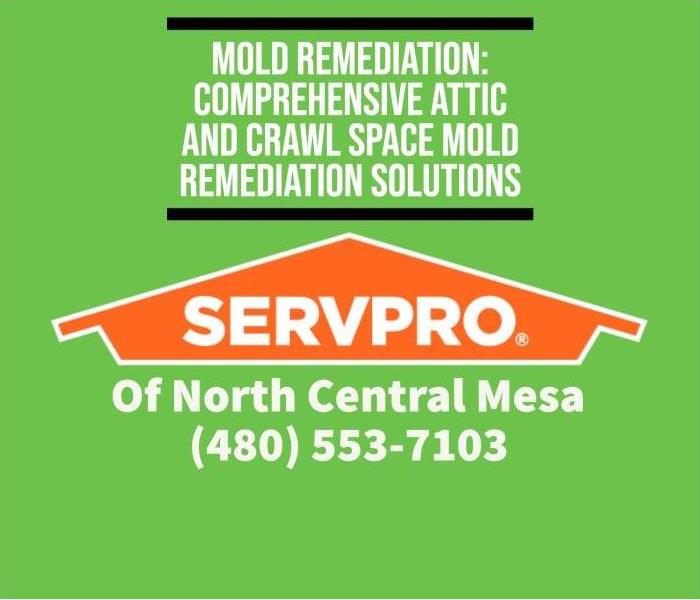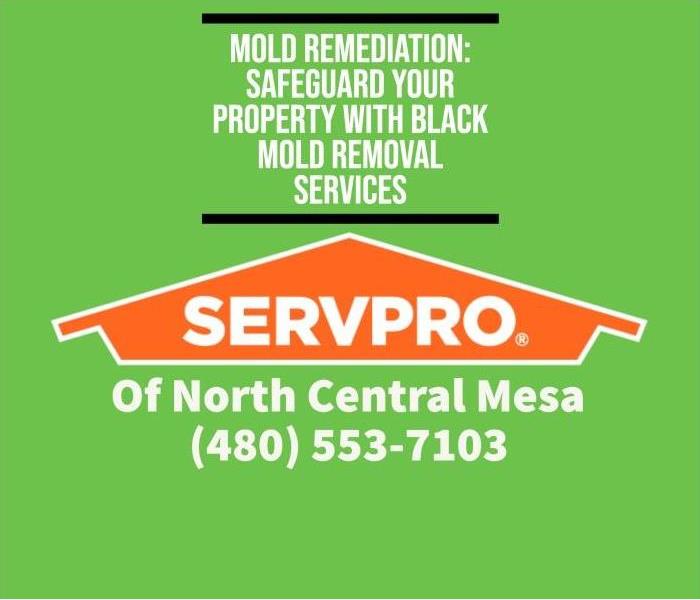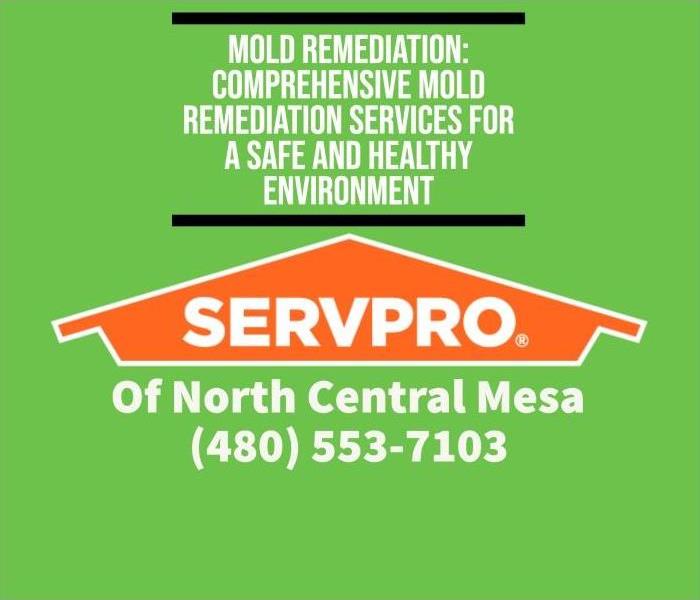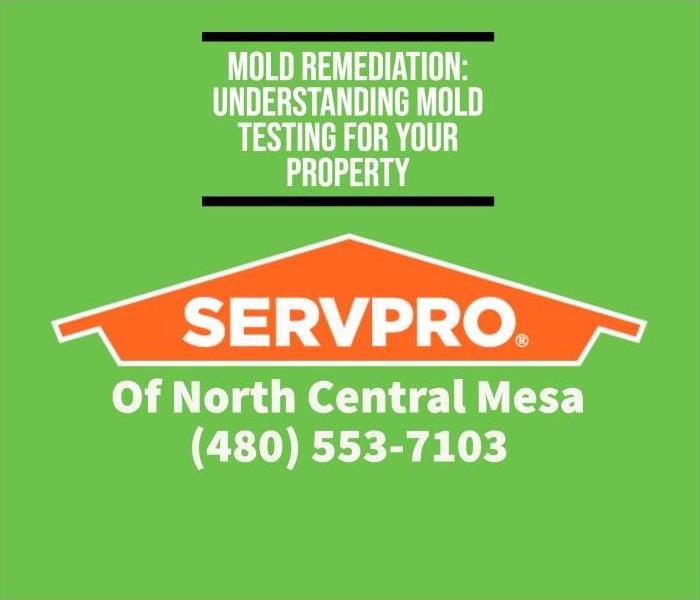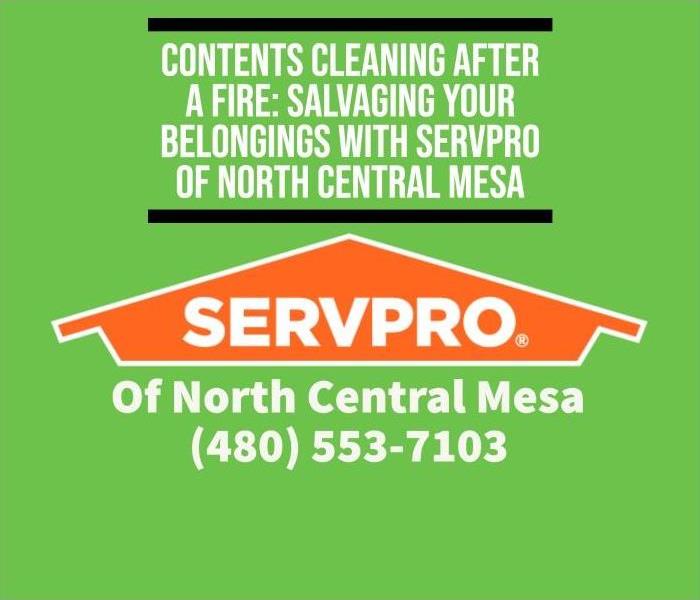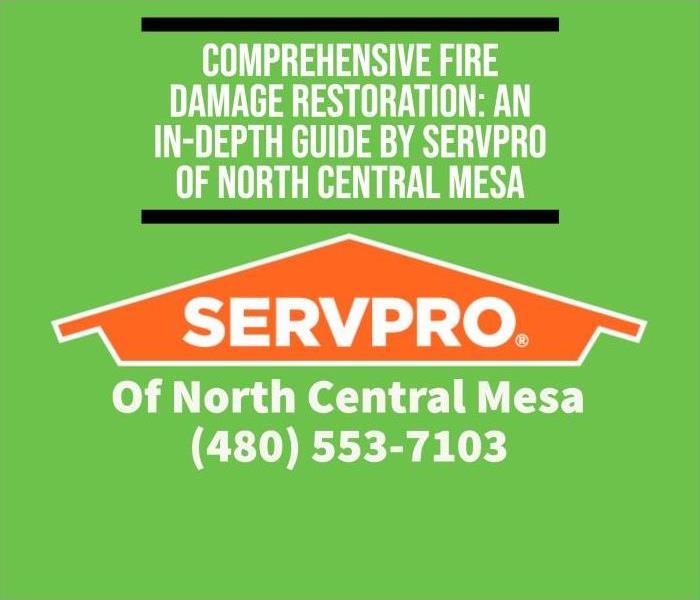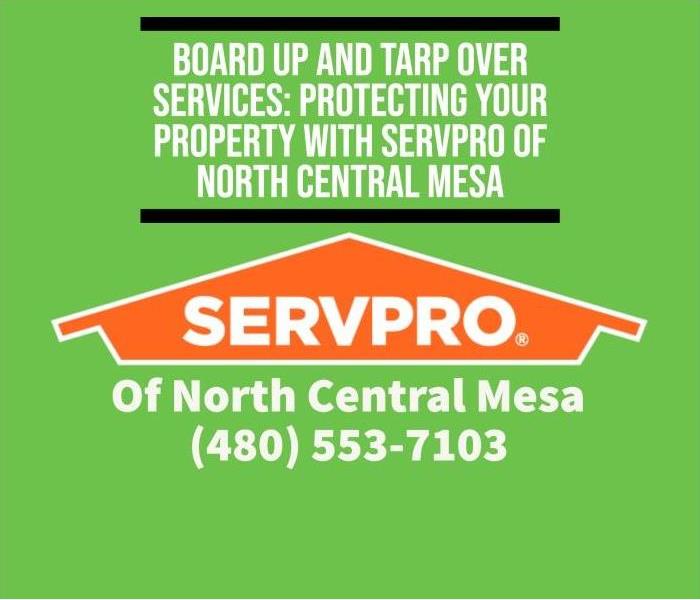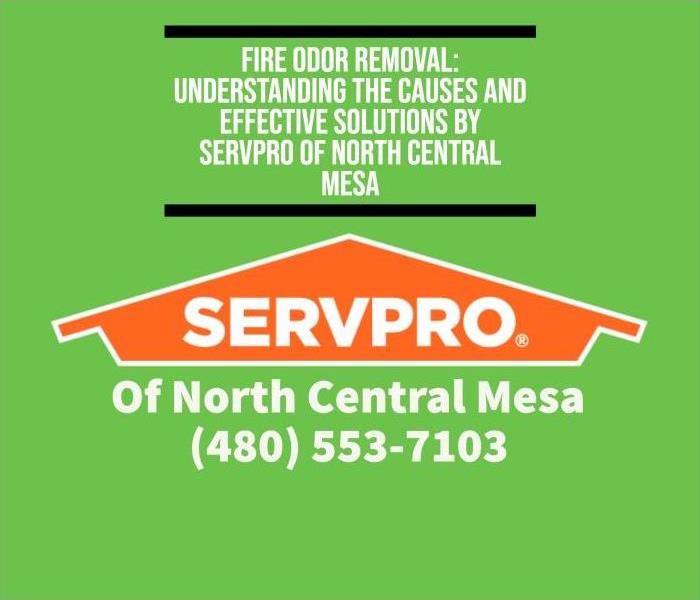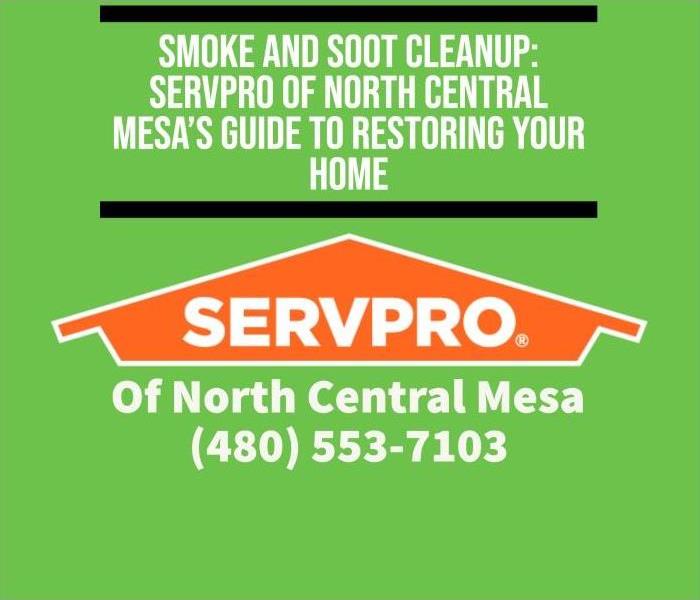Recent Posts
Mold Remediation: Ensuring Clean Air with HVAC Mold Remediation Services
4/5/2023 (Permalink)
Mold Remediation: Ensuring Clean Air with HVAC Mold Remediation Services
Mold growth in HVAC systems can lead to poor indoor air quality and pose health risks to building occupants. SERVPRO of North Central Mesa offers expert HVAC mold remediation services to ensure a safe and healthy environment for property owners and their occupants. In this blog post, we will discuss how mold grows in HVAC systems, how it is removed, and how to prevent HVAC mold growth. Additionally, we will provide a FAQ section to answer further questions related to HVAC mold remediation.
How Does Mold Grow in HVAC Systems?
Mold growth in HVAC systems is primarily caused by excess moisture and organic materials, which provide a suitable environment for mold to thrive. Common sources of mold growth in HVAC systems include:
- Condensation: High humidity levels and temperature fluctuations can lead to condensation within the HVAC system, providing moisture for mold growth.
- Leaks: Leaking ductwork or HVAC components can introduce moisture into the system, promoting mold growth.
- Dust and debris: Accumulation of dust and debris in the HVAC system can provide organic material for mold to feed on.
How is Mold Removed from HVAC Systems?
HVAC mold remediation involves several key steps to ensure thorough and effective removal of mold and prevention of future growth.
Inspection
A thorough inspection of the HVAC system is conducted to identify the extent of mold contamination and the source of the moisture problem. This information helps to develop a comprehensive remediation plan tailored to the specific needs of the property.
Containment
Containment is essential to prevent the spread of mold spores during the remediation process. Affected areas are sealed off using plastic sheeting and negative air pressure to ensure mold spores do not contaminate other parts of the property.
Mold-contaminated components of the HVAC system are carefully cleaned or replaced, depending on the severity of the contamination. Specialized equipment, such as HEPA vacuums and air scrubbers, may be used to remove mold spores from surfaces and the air.
Cleaning and Disinfection (H3): After mold removal, all surfaces and components within the HVAC system are thoroughly cleaned and disinfected to eliminate any remaining mold spores and prevent future growth. This process may involve the use of specialized cleaning agents and HEPA-filtered vacuums.
Drying and Dehumidification
To prevent future mold growth, it is crucial to address the underlying moisture problem. This may involve repairing leaks, drying wet materials, and using dehumidifiers to maintain appropriate humidity levels within the property.
System Maintenance
Regular maintenance of the HVAC system, including filter replacement and duct cleaning, can help prevent mold growth and ensure optimal system performance.
How Can HVAC Mold Growth Be Prevented?
Preventing mold growth in HVAC systems involves controlling moisture levels and maintaining proper system maintenance. Here are some tips for preventing HVAC mold growth:
- Regular maintenance: Schedule regular HVAC system maintenance, including filter replacement, coil cleaning, and ductwork inspection, to keep the system clean and functioning efficiently.
- Monitor humidity levels: Maintain indoor humidity levels between 30% and 50% to minimize the risk of condensation and mold growth.
- Inspect for leaks: Regularly inspect your HVAC system for leaks and promptly repair any issues found.
- Improve ventilation: Ensure adequate ventilation in your property to help control humidity levels and prevent moisture buildup.
Q: How do I know if there is mold in my HVAC system?
A: Signs of mold in your HVAC system may include a musty odor, unexplained allergic symptoms or respiratory issues, and visible mold growth on or around air vents and ductwork.
Q: Can I clean mold from my HVAC system myself?
A: DIY mold removal in HVAC systems is not recommended due to the potential health risks and the complexity of the system. Hiring certified professionals with the necessary training, experience, and equipment ensures safe and effective mold remediation.
Q: How much does HVAC mold remediation cost?
A: The cost of HVAC mold remediation varies depending on the severity of the mold issue and the size of the affected area. If you are in the Mesa, AZ area, Contact SERVPRO of North Central Mesa for a detailed estimate based on your specific needs.
Q: How long does HVAC mold remediation take?
A: The duration of HVAC mold remediation depends on the extent of the mold contamination and the size of the affected area. Smaller projects may take just a few days, while larger or more complex remediation can take several weeks.
Q: Can mold in my HVAC system affect my indoor air quality?
A: Yes, mold growth in your HVAC system can negatively impact your indoor air quality, as mold spores can be circulated throughout your property via the air ducts. This can lead to increased allergic symptoms and respiratory issues for building occupants.
HVAC mold remediation is essential for maintaining a safe and healthy environment for property owners and occupants. SERVPRO of North Central Mesa offers comprehensive HVAC mold remediation services, effectively addressing mold issues in your HVAC system and ensuring optimal indoor air quality. If you suspect mold in your HVAC system, contact our team of certified professionals to schedule an assessment and discuss your specific needs.
Mold Remediation: Comprehensive Attic and Crawl Space Mold Remediation Solutions
4/5/2023 (Permalink)
Mold growth in attics and crawl spaces can pose significant health risks and property damage if not promptly addressed. SERVPRO of North Central Mesa offers expert attic and crawl space mold remediation services to ensure a safe and healthy environment for property owners and their occupants. In this blog post, we will discuss the causes of mold growth in attics and crawl spaces, how mold is removed from these areas, and the risks associated with mold exposure. Additionally, we will provide a FAQ section to answer further questions related to attic and crawl space mold remediation.
What Causes Mold in Attics and Crawl Spaces?
Mold growth in attics and crawl spaces is primarily caused by excess moisture and inadequate ventilation. Common causes of moisture in these areas include:
Roof leaks
Damaged or missing shingles, improper flashing installation, and ice dams can lead to water intrusion in the attic, creating a breeding ground for mold.
Plumbing leaks:
Leaking pipes in the walls or ceiling can cause moisture buildup in the attic or crawl space, promoting mold growth.
Condensation
High humidity levels and poor ventilation can lead to condensation, particularly on cool surfaces in the attic or crawl space, providing an ideal environment for mold.
Inadequate vapor barriers
Improperly installed or missing vapor barriers in crawl spaces can allow ground moisture to enter and encourage mold growth.
How is Mold Removed from Attics and Crawl Spaces?
Mold remediation in attics and crawl spaces involves several key steps to ensure thorough and effective removal of mold and prevention of future growth.
Assessment
A thorough inspection is conducted to identify the extent of the mold contamination, the types of mold present, and the source of the moisture problem. This information helps to develop a comprehensive remediation plan tailored to the specific needs of the property.
Containment
Containment is essential to prevent the spread of mold spores during the remediation process. Affected areas are sealed off using plastic sheeting and negative air pressure to ensure mold spores do not contaminate other parts of the property.
Mold Removal
Mold removal involves the physical removal of mold-contaminated materials. This may include the use of specialized equipment, such as HEPA vacuums and air scrubbers, to remove mold spores from surfaces and the air. In some cases, porous materials, like insulation, may need to be discarded and replaced due to extensive contamination.
Cleaning and Disinfection
After mold removal, all surfaces and belongings in the affected area are thoroughly cleaned and disinfected to eliminate any remaining mold spores and prevent future growth. This process may involve the use of specialized cleaning agents and HEPA-filtered vacuums.
Drying and Dehumidification (H3): To prevent future mold growth, it is crucial to address the underlying moisture problem. This may involve repairing leaks, drying wet materials, and using dehumidifiers to maintain appropriate humidity levels within the property.
Restoration
Once the mold remediation process is complete, the property is restored to its pre-mold condition. This may include replacing damaged materials, repainting walls, or reinstalling insulation.
What are the Risks of Mold Exposure?
Mold exposure can cause various health problems, particularly for individuals with pre-existing respiratory conditions or compromised immune systems. Common health risks associated with mold exposure include:
Allergic reactions
Mold exposure can trigger allergic symptoms such as sneezing, runny nose, itchy eyes, and skin irritation.
- Respiratory issues: Mold spores can cause respiratory problems, including coughing, wheezing, and difficulty breathing, especially in individuals with asthma or other respiratory conditions.
- Infections: In rare cases, mold exposure can lead to fungal infections, particularly in individuals with weakened immune systems.
- Long-term health effects: Prolonged mold exposure may increase the risk of developing chronic respiratory conditions or exacerbate pre-existing health issues.
Attic and Crawl Space Mold Remediation Solutions FAQs:
Q: How can I prevent mold growth in my attic and crawl space?
A: Preventing mold growth in attics and crawl spaces involves controlling moisture levels and ensuring proper ventilation. Regularly inspect your property for leaks, promptly repair any water damage, install vapor barriers in crawl spaces, and ensure your attic has adequate ventilation.
Q: How do I know if I have mold in my attic or crawl space?
A: Signs of mold in attics and crawl spaces include visible mold growth, a musty odor, unexplained allergic symptoms or respiratory issues, and a history of water damage or moisture problems in your property.
Q: How much does attic and crawl space mold remediation cost?
A: The cost of attic and crawl space mold remediation varies depending on the severity of the mold issue and the size of the affected area. Contact SERVPRO of North Central Mesa for a detailed estimate based on your specific needs.
Q: Can I remove mold from my attic or crawl space myself?
A: DIY mold removal is not recommended, as it can be dangerous and may not effectively address the issue. Certified professionals have the necessary knowledge, experience, and equipment to safely and effectively remove mold and prevent future growth.
Q: How long does attic and crawl space mold remediation take?
A: The duration of attic and crawl space mold remediation depends on the extent of the mold contamination and the size of the affected area. Smaller projects may take just a few days, while larger or more complex remediation can take several weeks.
Attic and crawl space mold remediation is essential for ensuring the safety and well-being of property owners and occupants. SERVPRO of North Central Mesa offers comprehensive mold remediation services, effectively addressing your mold concerns and restoring a healthy environment. If you suspect mold issues in your attic or crawl space, contact our team of certified professionals to schedule an assessment and discuss your specific needs.
Mold Remediation: Safeguard Your Property with Black Mold Removal Services
4/5/2023 (Permalink)
Black mold, also known as Stachybotrys chartarum, is a particularly concerning type of mold that can cause significant health issues and property damage if not addressed promptly. SERVPRO of North Central Mesa offers expert black mold removal services to ensure the safety and well-being of property owners and their occupants. In this blog post, we will discuss what black mold is, why it's dangerous, and how it's removed. We will also provide a FAQ section to answer additional questions related to black mold removal.
What is Black Mold?
Black mold is a toxic mold species that is greenish-black in color and often has a musty odor. It typically grows on cellulose-rich materials such as wood, drywall, and paper, particularly in damp or humid conditions. Black mold produces mycotoxins, which are toxic compounds that can cause a range of health problems when inhaled or ingested.
Why is Black Mold Dangerous?
Black mold poses significant health risks due to the production of mycotoxins. Exposure to these toxins can cause a variety of symptoms, including respiratory issues, allergic reactions, skin irritation, and even neurological problems in severe cases. Black mold can also cause substantial property damage if left untreated, as it can weaken the structural integrity of building materials.
Black mold removal follows a similar process to general mold remediation but requires extra precautions due to the toxic nature of the mold. Certified professionals should handle black mold removal to ensure the safety of all parties involved.
Assessment
A thorough assessment is conducted to determine the extent of the black mold contamination, the types of materials affected, and the source of the moisture problem. This information is used to develop a comprehensive black mold removal plan tailored to the specific needs of the property.
Containment
During black mold removal, containment is crucial to prevent the spread of toxic spores. Affected areas are sealed off using plastic sheeting and negative air pressure to keep mold spores from contaminating other parts of the property.
Personal Protective Equipment
Due to the toxic nature of black mold, professionals wear appropriate personal protective equipment (PPE) during the removal process. This typically includes full-body suits, gloves, goggles, and respirators with HEPA filters.
Mold Removal
Black mold-contaminated materials are carefully removed and disposed of according to local regulations. Non-porous surfaces can be cleaned using specialized cleaning agents, while porous materials may need to be replaced.
Cleaning and Disinfection
Once the black mold has been removed, all surfaces and belongings in the affected area are thoroughly cleaned and disinfected to eliminate any remaining spores and toxins.
Drying and Dehumidification
Addressing the underlying moisture problem is essential to prevent future black mold growth. This may involve repairing leaks, drying wet materials, and using dehumidifiers to maintain appropriate humidity levels within the property.
Restoration
After the black mold removal process is complete, the property is restored to its pre-mold condition. This may include replacing damaged materials, repainting walls, or reinstalling carpets.
FAQs
Q: How can I prevent black mold growth in my property?
A: Preventing black mold growth involves controlling moisture levels and maintaining proper ventilation. Regularly inspect your property for leaks, promptly repair any water damage, use dehumidifiers in high-humidity areas, and ensure your HVAC system is functioning efficiently.
Q: How long does black mold removal take ?
A: The duration of black mold removal depends on the extent of the contamination and the size of the affected area. Smaller projects may take just a few days, while larger or more complex removals can take several weeks.
A: The cost of black mold removal varies depending on the severity of the mold issue and the size of the affected area. Contact SERVPRO of North Central Mesa for a detailed estimate based on your specific needs.
Q: Can I remove black mold myself?
A: DIY black mold removal is strongly discouraged due to the health risks associated with exposure to toxic mold spores. It is crucial to hire certified professionals with the necessary training, experience, and equipment to safely and effectively remove black mold.
Q: What are the signs of black mold in my property?
A: Signs of black mold may include visible mold growth with a greenish-black appearance, a musty odor, and unexplained health issues such as respiratory problems or allergic reactions.
Black mold removal is a critical service for ensuring the safety and well-being of property owners and occupants. SERVPRO of North Central Mesa offers expert black mold removal services to effectively address your mold concerns and restore a healthy environment. If you suspect black mold in your home or business, contact our team of certified professionals to schedule an assessment and discuss your specific needs.
Mold Remediation: Comprehensive Mold Remediation Services for a Safe and Healthy Environment
4/5/2023 (Permalink)
Mold growth can pose significant risks to your property and health, making mold remediation a crucial service. SERVPRO of North Central Mesa offers expert mold remediation services, ensuring the safety and well-being of property owners and their occupants. In this blog post, we will discuss what mold remediation is, how it's done, and the steps involved in the process. We will also provide a FAQ section to answer additional questions related to mold remediation services.
Mold remediation is the process of removing and cleaning mold-contaminated materials from a property to restore a healthy environment. This includes identifying the source of the mold, containing and removing affected materials, and preventing future mold growth. Mold remediation is best performed by certified professionals who have the necessary training, expertise, and equipment to safely and effectively address mold issues.
How is Mold Remediation Done?
Mold remediation typically involves several key steps to ensure thorough and effective removal of mold and prevention of future growth.
Steps for Mold Remediation
Assessment
The first step in mold remediation is a thorough assessment of the property. This includes identifying the extent of the mold contamination, the types of mold present, and the source of the moisture problem. This information helps to develop a comprehensive remediation plan tailored to the specific needs of the property.
Containment
Containment is essential to prevent the spread of mold spores during the remediation process. Affected areas are sealed off using plastic sheeting and negative air pressure to ensure mold spores do not contaminate other parts of the property.
Mold Removal
Mold removal involves the physical removal of mold-contaminated materials. This may include the use of specialized equipment, such as HEPA vacuums and air scrubbers, to remove mold spores from surfaces and the air. In some cases, porous materials, like drywall and insulation, may need to be discarded and replaced due to extensive contamination.
Cleaning and Disinfection
After mold removal, all surfaces and belongings in the affected area are thoroughly cleaned and disinfected to eliminate any remaining mold spores and prevent future growth. This process may involve the use of specialized cleaning agents and HEPA-filtered vacuums.
Drying and Dehumidification
To prevent future mold growth, it is crucial to address the underlying moisture problem. This may involve repairing leaks, drying wet materials, and using dehumidifiers to maintain appropriate humidity levels within the property.
Restoration
Once the mold remediation process is complete, the property is restored to its pre-mold condition. This may include replacing damaged materials, repainting walls, or reinstalling carpets.
FAQs
Q: How long does mold remediation take?
A: The duration of mold remediation depends on the extent of the mold contamination and the size of the affected area. Smaller projects may take just a few days, while larger or more complex remediation can take several weeks.
Q: How much does mold remediation cost?
A: The cost of mold remediation varies depending on the severity of the mold issue and the size of the affected area. Contact SERVPRO of North Central Mesa for a detailed estimate based on your specific needs.
Q: Can I perform mold remediation myself?
A: DIY mold remediation is not recommended, as it can be dangerous and may not effectively address the issue. Certified professionals have the necessary knowledge, experience, and equipment to safely and effectively remove mold and prevent future growth. Attempting mold remediation without proper training and equipment can put your health at risk and may exacerbate the problem.
Q: Is mold remediation covered by insurance?
A: Mold remediation may be covered by insurance, depending on the cause of the mold and the specifics of your policy. It is important to review your insurance policy and contact your insurance provider for more information on coverage for mold remediation services.
Q: What are the signs that I need mold remediation?
A: Signs that you may need mold remediation include visible mold growth, a musty odor, unexplained allergic symptoms or respiratory issues, and a history of water damage or moisture problems in your property.
Mold remediation is essential for addressing mold issues and restoring a safe and healthy environment in your property. SERVPRO of North Central Mesa offers comprehensive mold remediation services, ensuring effective and long-lasting solutions to your mold concerns. If you suspect mold issues in your home or business, contact our team of certified professionals to schedule an assessment and discuss your specific needs.
Mold Remediation: Understanding Mold Testing for Your Property
4/5/2023 (Permalink)
Mold growth can have adverse effects on your property and your health, making mold remediation an essential service. SERVPRO of North Central Mesa is committed to providing homeowners and businesses with the information they need to understand mold testing and its benefits. This blog post covers the basics of mold testing, how it's done, and the benefits it can provide to ensure a safe and healthy environment. We will also provide a FAQ section to answer other common questions related to mold testing.
What is Mold Testing?
Mold testing is a process used to detect the presence of mold in a building or property. This procedure is often necessary when mold is suspected but not visible or when a building has experienced water damage. Mold testing helps to identify the type and extent of mold contamination, allowing for effective mold remediation strategies. Mold tests are performed by certified mold inspectors, ensuring accurate and reliable results.
Visual Inspection:
The first step in mold testing is a thorough visual inspection of the property. This inspection is done to identify any visible signs of mold growth, water damage, or moisture issues. The inspector will examine walls, ceilings, floors, crawlspaces, and ventilation systems for any signs of mold or conducive conditions.
Air sampling is a common method used to test for mold spores in the air. The inspector collects air samples from various locations within the property and sends them to a laboratory for analysis. This method helps determine the concentration of mold spores in the air and identify the specific types of mold present.
Surface Sampling:
Surface sampling involves collecting samples from surfaces suspected of harboring mold growth. This can be done using swabs, tape lifts, or bulk samples. These samples are then sent to a lab for microscopic analysis to confirm the presence of mold and identify the species.
Moisture and Humidity Measurements:
High humidity levels and moisture are key factors contributing to mold growth. During mold testing, inspectors measure the moisture content of materials and the relative humidity levels in the property. This information helps identify areas at risk for mold growth and guides the remediation process.
The Benefits of Mold Testing
Health and Safety:
Mold can cause a variety of health issues, especially for individuals with allergies, asthma, or weakened immune systems. Mold testing helps to identify and address mold issues early, reducing the risk of health problems and ensuring a safe environment for occupants.
Accurate Remediation:
Mold testing allows for targeted and efficient mold remediation. By identifying the specific types and locations of mold, remediation efforts can be focused on the areas that need it most. This ensures thorough and effective mold removal, preventing recurrence.
Prevent Property Damage:
Unchecked mold growth can cause significant property damage, weakening the structural integrity of your home or business. Mold testing helps to identify and address mold issues before they become severe, saving you time and money on repairs.
Maintain Property Value:
Mold issues can negatively impact the value of a property. By conducting mold testing and addressing any issues, you can maintain or even increase your property's value, making it more attractive to potential buyers.
FAQs
Q: How much does mold testing cost?
A: The cost of mold testing varies depending on the size of the property and the complexity of the testing required. Contact SERVPRO of North Central Mesa for a detailed estimate based on your specific needs.
Q: How long does mold testing take?
A: The duration of mold testing can vary, but most inspections and sampling can be completed within a few hours. However, laboratory analysis of the samples may take several days, after which you will receive a detailed report on the findings.
Q: Can I perform mold testing myself?
A: While DIY mold testing kits are available, it is highly recommended that you hire a certified mold inspector to conduct the testing. Professional inspectors have the necessary knowledge, experience, and equipment to accurately assess mold issues, ensuring the most effective remediation plan.
Q: When should I consider mold testing?
A: Mold testing should be considered if you suspect mold growth but cannot visibly locate it, if your property has experienced water damage, or if you notice a musty odor. Additionally, mold testing can be beneficial during real estate transactions or as part of routine property maintenance.
Q: How can I prevent mold growth?
A: Preventing mold growth involves controlling moisture levels and maintaining proper ventilation. Regularly inspect your property for leaks, promptly repair any water damage, use dehumidifiers in high-humidity areas, and ensure your HVAC system is functioning efficiently.
Mold testing is a critical component of mold remediation, providing valuable information about the type and extent of mold contamination in your property. SERVPRO of North Central Mesa is here to help you navigate the mold testing process, ensuring a safe and healthy environment for you and your family. If you suspect mold issues in your home or business, don't hesitate to contact our team of professionals to schedule a mold inspection and discuss your specific needs.
Contents Cleaning After a Fire: Salvaging Your Belongings with SERVPRO of North Central Mesa
3/27/2023 (Permalink)
When a fire strikes, the damage to your home's structure is not the only concern. Your personal belongings are also at risk of being damaged or destroyed. The good news is that many items can be salvaged and restored through a professional contents cleaning process. In this blog post, we will discuss how contents are cleaned after a fire, which items can be salvaged, and the contents cleaning process used by SERVPRO of North Central Mesa in Mesa, AZ.
How are Contents Cleaned After a Fire?
Contents cleaning involves a combination of specialized equipment, techniques, and cleaning solutions to remove smoke, soot, and other contaminants from your belongings. The goal is to restore your items to their pre-fire condition as much as possible. SERVPRO of North Central Mesa utilizes a variety of cleaning methods based on the type of item and the extent of the damage.
What Items Can Be Salvaged?
Many items can be salvaged after a fire, depending on the material and the extent of the damage. Some examples of salvageable items include:
- Furniture: Solid wood and metal furniture can often be restored, while upholstered furniture may be more challenging due to smoke and soot penetration.
- Textiles: Curtains, carpets, clothing, and other fabrics can often be cleaned and restored, although some may be permanently damaged by high heat or heavy smoke exposure.
- Electronics: Electronics can often be restored if they have not been directly exposed to high heat or flames. However, smoke and soot can cause damage to internal components if not promptly addressed.
- Artwork and Collectibles: Many types of artwork and collectibles can be restored, depending on the material and the extent of the damage.
- Personal Documents: In some cases, personal documents like photographs, birth certificates, and legal documents can be restored using specialized techniques.
The contents cleaning process used by SERVPRO of North Central Mesa involves several steps:
- Inventory and Assessment: Our team will inventory and assess your belongings to determine which items can be salvaged and the appropriate cleaning method for each.
- Packing and Transport: Salvageable items will be carefully packed and transported to our secure, climate-controlled facility for cleaning and restoration.
- Cleaning and Deodorization: Our professionals will use a combination of cleaning methods, such as ultrasonic cleaning, dry cleaning, wet cleaning, and immersion cleaning, to remove smoke, soot, and other contaminants from your belongings. Advanced deodorization techniques will also be used to eliminate lingering odors.
- Drying and Humidity Control: To prevent mold growth and further damage, we will ensure that all items are properly dried and stored in a controlled environment.
- Storage: Cleaned and restored items will be securely stored in our facility until your home is ready for their return.
- Return and Reinstallation: Once your home is fully restored, our team will carefully return and reinstall your belongings.
SERVPRO's Ready app is a mobile application designed to help property owners and managers create an Emergency Ready Profile (ERP) for their homes or businesses, which can be invaluable in the event of a fire or other disaster. The app aims to streamline communication, improve response times, and minimize damage by providing crucial information and resources at your fingertips. Here's how the SERVPRO Ready app can help you prepare for a fire before it happens:
- Property details: The app allows you to create a profile for your property, including essential information such as property layout, utility shutoff locations, and emergency contact details. This information can be crucial for first responders and restoration professionals in case of a fire.
- Emergency contacts: You can store contact information for emergency services, utility providers, insurance agents, and property managers, making it easy to access and share this information during a crisis.
- Contingency planning: The ERP helps you create a detailed plan for evacuation, communication, and recovery, ensuring that you and your family or employees know what to do in case of a fire.
- Access to resources: The app provides access to helpful resources, such as tips for fire prevention and preparedness, as well as information on what to do during and after a fire.
- Shareable profiles: You can share your Emergency Ready Profile with relevant parties, such as family members, employees, or property managers, ensuring everyone is aware of the plan and can access critical information during an emergency.
- Damage documentation: In the event of a fire, the app allows you to document the damage with photos and notes, which can be helpful for insurance claims and restoration purposes.
- Easy connection to SERVPRO professionals: The app enables you to quickly contact your local SERVPRO franchise in case of a fire or other emergency, ensuring a prompt response and beginning the restoration process as soon as possible.
Contents cleaning is a critical aspect of the fire damage restoration process, helping to salvage and restore your cherished belongings. Trust the professionals at SERVPRO of North Central Mesa in Mesa, AZ, to handle your contents cleaning needs with the utmost care and expertise. Contact us today for expert contents cleaning and fire damage restoration services.
Comprehensive Fire Damage Restoration: An In-Depth Guide by SERVPRO of North Central Mesa
3/27/2023 (Permalink)
Experiencing a fire in your home can be an overwhelming and traumatic event. After the fire has been extinguished, it's crucial to address the damage and begin the restoration process. In this blog post, we will discuss the types of damage a fire can cause, how fire damage is repaired, and how long the repair process may take.
Additionally, we'll address some frequently asked questions about fire damage repair. Trust the experts at SERVPRO of North Central Mesa in Mesa, AZ, to help you navigate the fire damage repair process and restore your home to its pre-fire condition.
What Types of Damage Can Fire Cause?
Fire can cause a variety of damage to your home, including:
- Structural Damage: The heat from a fire can weaken or even destroy essential structural components, such as walls, ceilings, and support beams.
- Smoke Damage: Smoke can permeate every nook and cranny of your home, causing discoloration, foul odors, and even health risks.
- Soot Damage: Soot is a fine, black residue that forms when incomplete combustion occurs. It can settle on various surfaces, leaving behind a grimy, oily film that is difficult to remove.
- Water Damage: In many cases, water damage from firefighting efforts can compound the issues caused by fire, leading to additional challenges in the restoration process.
10 Steps to take after a fire has been put out at your property
After the fire department has put out a fire at your property, it's crucial to take appropriate steps to ensure the safety and well-being of everyone involved and to start the recovery process. Here are the first steps you should follow:
- Ensure safety: Wait for the fire department to confirm that it is safe to enter the property. There may be hidden dangers, such as weakened structures, electrical hazards, or hotspots that could reignite.
- Contact your insurance company: Notify your insurance provider about the fire as soon as possible. They will guide you through the claims process and may recommend fire restoration professionals to assess and repair the damage.
- Secure the property: If possible, secure the property to prevent unauthorized access, theft, or vandalism. This may involve boarding up windows and doors, installing temporary fencing, or covering damaged roofs with tarps. Consult with your insurance company, as they may require specific measures to be taken.
- Document the damage: Take photos and videos of the damage to your property, both inside and outside, before any cleanup or repairs begin. This documentation will be crucial for your insurance claim and can help the restoration process.
- Arrange temporary housing: If your property is uninhabitable, make arrangements for temporary housing for yourself and your family. Your insurance policy may include coverage for additional living expenses to help with this cost.
- Retrieve essential items: If it is safe to enter the property, collect important personal items, such as identification, medication, essential documents, and valuable belongings. However, do not attempt to clean or move damaged items without guidance from a professional, as this may cause further damage or compromise your insurance claim.
- Hire a professional restoration company: Contact a reputable, IICRC-certified fire and smoke damage restoration company to assess the damage, provide an estimate for repairs, and begin the cleanup and restoration process.
- Notify relevant parties: Inform your utility providers, mortgage company, and other relevant parties about the fire, as they may need to adjust billing or services.
- Keep records: Maintain thorough records of all communications, expenses, receipts, and other relevant information related to the fire and restoration process. This will be important for your insurance claim and for tax purposes.
- Take care of yourself and your family: Experiencing a fire can be emotionally and physically draining. Seek support from friends, family, or professional counselors to help you cope with the stress and emotions during this difficult time.
Remember that safety should always be your top priority. Consult with professionals and follow their advice to ensure the recovery process is carried out safely and effectively.
How is Fire Damage Repaired?
SERVPRO of North Central Mesa follows a comprehensive approach to fire damage repair:
- Assessment: Our trained professionals will first assess the extent of the damage to determine the best course of action for repair and restoration.
- Board-Up and Roof-Tarp Services: We will secure your property by boarding up windows and doors and installing roof tarps to prevent further damage from the elements.
- Water Removal and Drying: If water damage is present, we will extract the water and use specialized equipment to dry your home thoroughly.
- Smoke and Soot Removal: Our team will clean all affected surfaces, removing smoke and soot residues using industry-leading techniques and cleaning products.
- Cleaning, Sanitizing, and Odor Removal: We will clean and sanitize all restorable items, such as furniture, textiles, and personal belongings, to help restore them to their pre-fire condition.
- Restoration: Our team will repair and restore damaged structural components, including walls, ceilings, and floors. In some cases, this may involve reconstruction work, such as installing new drywall or flooring.
How Long Does Fire Damage Repair Take?
The duration of the fire damage repair process depends on the extent of the damage and the specific needs of your home. On average, fire damage repair can take anywhere from a few weeks to a few months. The professionals at SERVPRO of North Central Mesa will work diligently to complete the repair process as quickly and efficiently as possible while ensuring the highest quality of work.
IICRC certified technicians use a variety of specialized equipment and tools to effectively address fire damage repair and restoration. The types of equipment used may vary depending on the specific needs of the project, but some common tools and equipment include:
- Personal Protective Equipment (PPE): Technicians wear PPE, such as gloves, respirators or masks, goggles, and protective clothing, to safeguard themselves from potential hazards during the restoration process.
- Inspection tools: These may include moisture meters, thermal imaging cameras, and hygrometers, which help technicians assess the extent of the damage, detect hidden moisture, and monitor the drying process.
- HEPA-filtered vacuums: High-Efficiency Particulate Air (HEPA) vacuums are used to remove soot, dust, and other fine particles from surfaces without dispersing them into the air.
- Air scrubbers and negative air machines: These devices help to clean and filter the air, removing airborne particles and contaminants to improve indoor air quality.
- Ozone generators and hydroxyl generators: These machines produce ozone or hydroxyl radicals, which help to neutralize and eliminate odors caused by fire and smoke.
- Thermal foggers and ULV foggers: These fogging machines disperse fine deodorizing particles that can penetrate porous materials to neutralize odors and sanitize affected areas.
- Cleaning agents and chemicals: Technicians use specialized cleaning agents and chemicals designed for fire damage restoration, such as soot and smoke cleaners, degreasers, and odor neutralizers.
- Pressure washers and steam cleaners: These machines are used to clean and sanitize surfaces, remove soot and residues, and deodorize affected areas.
- Water extraction and drying equipment: In cases where water damage has occurred due to firefighting efforts, technicians may use water extraction units, air movers, and dehumidifiers to remove excess moisture and dry out the affected areas.
- Restoration tools: Various tools, such as sponges, brushes, scrapers, and sanders, are used to clean and restore surfaces damaged by fire and smoke.
These are just some of the tools and equipment that IICRC certified technicians may use during the fire damage repair and restoration process. The specific equipment used will depend on the extent of the damage, the types of materials affected, and the restoration needs of the property.
FAQs About Fire Damage Repair:
How can I prevent mold growth after a fire?
To prevent mold growth, it's crucial to address any water damage as quickly as possible. SERVPRO of North Central Mesa will extract standing water, thoroughly dry affected areas, and monitor humidity levels to minimize the risk of mold growth.
Will my insurance cover fire damage repair costs?
Most homeowners' insurance policies cover fire damage repair. However, it's essential to consult with your insurance company to understand the specific details of your coverage.
Can I stay in my home during the fire damage repair process?
Depending on the extent of the damage, it may be unsafe or uncomfortable to remain in your home during the repair process. Your SERVPRO of North Central Mesa project manager will advise you on the best course of action regarding
Board Up and Tarp Over Services: Protecting Your Property with SERVPRO of North Central Mesa
3/27/2023 (Permalink)
In the aftermath of a disaster, such as a fire, storm, or other damaging event, securing your property and preventing further damage becomes a top priority. Board up and tarp over services provide a temporary solution to protect your home until more permanent repairs can be made.
Let's discuss when board up and tarp over services are necessary, how they are done, and how long they take. Additionally, we'll address some frequently asked questions about these services. Trust the experts at SERVPRO of North Central Mesa, located in Mesa, AZ, to secure and protect your property when it matters most.
When is Board Up and Tarp Over Necessary?
Board up and tarp over services are necessary in situations where your property has been compromised and exposed to the elements or potential trespassers. Some common scenarios include:
- After a fire: Fire damage can leave your home with broken windows, doors, and damaged walls, leaving your property vulnerable to weather, animals, and unauthorized entry.
- Storm damage: High winds, hail, or heavy rain can cause significant damage to your roof, windows, and doors, leaving your home exposed to further damage from the elements.
- Vandalism or break-ins: In the unfortunate event of vandalism or a break-in, your home may require immediate board up services to secure the property and prevent further incidents.
How is Board Up and Tarp Over Done?
SERVPRO of North Central Mesa follows a thorough process to ensure your property is effectively secured:
- Assessment: Our team will assess the damage to your property and determine the necessary board up and tarp over services required.
- Measurement: We will carefully measure all openings, such as windows, doors, and roof damage, to ensure proper fit for the boards and tarps.
- Board Up: Our team will use high-quality plywood and secure fasteners to cover damaged windows and doors, preventing unauthorized entry and weather intrusion.
- Tarp Over: For roof damage, we will use durable, waterproof tarps to cover the affected areas, providing temporary protection from rain and other elements.
- Cleanup: Our team will clean up any debris resulting from the damage and the installation process.
How Long Does Board Up and Tarp Over Take?
The duration of the board up and tarp over process depends on the extent of the damage and the size of your property. In most cases, these services can be completed within a few hours to a day. The professionals at SERVPRO of North Central Mesa work quickly and efficiently to secure your property, providing you with peace of mind.
FAQs About Board Up and Tarp Over Services:
Will my insurance cover the cost of board up and tarp over services?
Most homeowners' insurance policies cover the cost of temporary protective measures, such as board up and tarp over services. It's essential to check with your insurance provider to understand the specific details of your coverage.
Can I perform board up and tarp over services myself?
While it may be tempting to try and secure your property on your own, it's crucial to consider the risks involved. Working on damaged structures can be dangerous, and improper installation may lead to further damage or inadequate protection. Hiring professionals like SERVPRO of North Central Mesa ensures a safe and effective solution.
How long will the boards and tarps remain in place?
Boards and tarps will typically remain in place until permanent repairs can be made. The duration may vary depending on factors such as the extent of the damage, insurance claims, and contractor availability.
What happens after the board up and tarp over services are completed?
Once your property is secured, the next step is to assess the full extent of the damage and develop a plan for restoration and repairs. Your SERVPRO of North Central Mesa project manager will work closely with you and your insurance company to ensure a smooth restoration process, from initial cleanup and mitigation to final reconstruction.
Can board up and tarp over services help prevent mold growth after water damage?
While board up and tarp over services primarily protect your property from further weather intrusion, they can also help prevent mold growth by reducing the amount of moisture entering your home. However, it's essential to address any existing water damage and initiate proper drying and dehumidification procedures to minimize mold risk.
Board up and tarp over services are crucial in protecting your property from further damage and providing a sense of security during a difficult time. Trust the experienced team at SERVPRO of North Central Mesa in Mesa, AZ, to provide prompt and professional board up and tarp over services, along with comprehensive restoration and repair solutions. Contact us today for expert assistance in securing and restoring your home.
Fire Odor Removal: Understanding the Causes and Effective Solutions by SERVPRO of North Central Mesa
3/27/2023 (Permalink)
A fire can leave behind not only visible damage but also persistent odors that serve as a constant reminder of the traumatic event. It's essential to address these odors to restore a comfortable living environment for you and your family. In this blog post, we will discuss what causes fire odor, how it's removed, and the methods SERVPRO of North Central Mesa uses to eliminate fire odors in your Mesa, AZ home.
What Causes Fire Odor?
Fire odors are caused by a combination of factors, including:
- Smoke: Smoke is the primary source of fire odors. It contains a mixture of toxic gases, volatile organic compounds, and fine particles that can permeate various surfaces in your home, leaving behind an unpleasant smell.
- Soot: Soot is the black residue that forms when organic materials burn incompletely. Soot particles can cling to surfaces and be difficult to remove, contributing to lingering odors.
- Burnt Materials: The burning of various materials like wood, plastics, fabrics, and synthetic materials during a fire can produce distinct odors that can persist long after the fire has been extinguished.
The Chemical Reactions Science behind Fire and Smoke Odor
Smoke odor is the result of complex chemical reactions that occur during the combustion process when a fire burns various materials. The main factors affecting smoke odor are the types of materials burned, the temperature at which they burn, and the availability of oxygen during combustion.
When materials burn, they undergo oxidation reactions, breaking down into smaller molecules and volatile organic compounds (VOCs). Some of these VOCs are responsible for the characteristic smell of smoke. Examples of odor-causing compounds include:
- Aldehydes: Formaldehyde, acetaldehyde, and other aldehydes are produced when materials containing cellulose (like wood, paper, and natural fibers) burn. These compounds often have a pungent and irritating odor.
- Phenols: Phenolic compounds are produced when plastics, synthetic fibers, and other materials containing hydrocarbons burn. They contribute to a strong, acrid odor.
- Ketones and organic acids: These compounds are produced from the incomplete combustion of various materials, including natural and synthetic fibers, and can contribute to the overall smoke odor.
- Sulfur-containing compounds: The combustion of materials containing sulfur, such as rubber and some plastics, can produce hydrogen sulfide, sulfur dioxide, and other sulfur-containing compounds. These substances can have a strong and unpleasant odor.
- Nitrogen-containing compounds: The burning of materials containing nitrogen, such as proteins and some plastics, can produce nitrogen-containing compounds like ammonia and hydrogen cyanide. These can also contribute to the unpleasant smell associated with smoke.
The intensity and nature of the smoke odor can be influenced by factors such as the type and amount of fuel (i.e., the material being burned), the combustion temperature, and the availability of oxygen. Hotter fires with more oxygen generally produce less smoke and odor, as they result in more complete combustion. However, incomplete combustion, which occurs in cooler, oxygen-poor fires, can produce more smoke and a stronger odor due to the higher concentration of partially oxidized compounds.
Eliminating smoke odor can be challenging because the odorous compounds can penetrate porous materials and linger long after the fire has been extinguished. Professional restoration services use specialized equipment and techniques, such as ozone generators, hydroxyl generators, or thermal fogging, to neutralize and remove smoke odors effectively.
How is Fire Odor Removed?
SERVPRO of North Central Mesa uses a multi-step process to remove fire odors:
- Assessment: Our trained professionals will first assess the extent of the odor problem and identify the sources of the odor in your home.
- Cleaning: We will thoroughly clean all affected areas, removing soot, smoke, and burnt materials from your home.
- Deodorization: Our team will utilize specialized deodorization techniques to neutralize and eliminate the remaining odors.
SERVPRO of North Central Mesa employs several techniques to effectively eliminate fire odors:
- Air Scrubbers: Air scrubbers use HEPA filters to remove particles, gases, and odors from the air, improving indoor air quality.
- Ozone Generators: Ozone generators produce ozone, which reacts with odor-causing molecules and neutralizes them, effectively eliminating stubborn odors.
- Thermal Fogging: Thermal fogging involves heating a deodorizing agent until it becomes a fine mist, which can penetrate deep into porous surfaces to neutralize odors at their source.
- Hydroxyl Generators: Hydroxyl generators produce hydroxyl radicals that break down odor-causing compounds, providing a safe and effective method for odor elimination.
Why use an IICRC Certified Technician?
Using an IICRC Certified Fire and Smoke Restoration Technician (FSRT) to remove fire odor is important for several reasons:
- Expert knowledge: IICRC Certified technicians possess in-depth knowledge of fire and smoke behavior, as well as the chemical reactions that produce odors and residues. They can accurately assess the damage and identify the most effective methods to eliminate odors and restore affected materials.
- Proper techniques and equipment: Certified FSRTs are trained in the latest techniques and use specialized equipment for odor removal, such as ozone generators, hydroxyl generators, and thermal foggers. They also know how to properly clean and restore various surfaces and materials without causing further damage.
- Health and safety: Fire and smoke damage can pose health risks due to toxic substances released during combustion. IICRC Certified technicians are trained to identify potential hazards and implement proper safety measures during the restoration process to protect both themselves and the occupants of the property.
- Quality assurance: IICRC certification ensures that technicians adhere to established industry standards, providing a level of quality assurance for the restoration work. This can give property owners peace of mind that the job will be done professionally and thoroughly.
- Insurance compliance: Many insurance companies require that restoration work be performed by IICRC-certified professionals. Hiring a certified technician can help ensure compliance with your insurance policy and may facilitate a smoother claims process.
- Efficient and effective restoration: IICRC Certified technicians have the knowledge and skills to address fire odors and damage quickly and effectively, which can help minimize further damage, reduce restoration costs, and allow you to return to your property sooner.
What is an IICRC Certified Fire and Smoke Restoration Technician?
The IICRC (Institute of Inspection, Cleaning and Restoration Certification) is an international non-profit organization that sets standards and provides certification for the inspection, cleaning, and restoration industries. One of the certifications offered by the IICRC is for fire and smoke damage restoration, known as the Fire and Smoke Restoration Technician (FSRT) certification.
The FSRT certification ensures that technicians have the necessary knowledge and skills to perform fire and smoke damage restoration effectively and safely. To obtain the certification, technicians must complete an IICRC-approved FSRT course and pass a comprehensive examination. The course covers a wide range of topics related to fire and smoke damage restoration, including:
- Principles of fire and smoke damage restoration: Understanding the behavior of fire, smoke, and the chemical reactions that produce odors and residues.
- Safety and health considerations: Identifying potential hazards and implementing appropriate safety measures during the restoration process.
- Inspection and pre-restoration evaluation: Assessing the extent of damage, identifying affected materials, and determining the best restoration approach.
- Cleaning techniques and procedures: Learning various cleaning methods, such as dry and wet cleaning, deodorization, and specialized techniques for different types of materials and surfaces.
- Structural restoration: Addressing structural damage, such as charred framing or damaged drywall, and coordinating with other professionals for necessary repairs.
- Contents restoration: Cleaning and restoring personal belongings, furniture, and appliances affected by fire and smoke damage.
- HVAC system cleaning: Understanding the importance of cleaning heating, ventilation, and air conditioning (HVAC) systems after fire and smoke damage to remove contaminants and improve indoor air quality.
By hiring an IICRC-certified FSRT, you can be assured that the technician has undergone proper training and adheres to the IICRC's standards for professional fire and smoke damage restoration. This ensures that the restoration process is carried out safely, effectively, and with the highest level of care for your property and belongings.
Fire odor removal is a crucial step in restoring your home to its pre-fire condition. The expert IICRC Certified team at SERVPRO of North Central Mesa, located in Mesa, AZ, is equipped with the knowledge, experience, and tools to eliminate even the most stubborn fire odors. Trust our professionals to help you regain a comfortable, odor-free living environment. Contact us today for expert fire odor removal services.
Smoke and Soot Cleanup: SERVPRO of North Central Mesa's Guide to Restoring Your Home
3/27/2023 (Permalink)
When disaster strikes, it's essential to act quickly to mitigate the damage and restore your home to its original condition. Fire damage can leave a lasting impact on your property, with smoke and soot being two of the most stubborn challenges homeowners face. Let's explore smoke damage, how it's cleaned up, and the process of removing soot from surfaces. SERVPRO of North Central Mesa, based in Mesa, AZ, is a trusted professional restoration company with the expertise to handle all of your smoke and soot cleanup needs.
What is Smoke Damage?
Smoke damage is the residue left behind after a fire has been extinguished. It can permeate every nook and cranny of your home, causing discoloration, odors, and even structural damage. The toxic particles in smoke can also pose health risks, making it crucial to address smoke damage as quickly as possible.
SERVPRO of North Central Mesa uses a comprehensive approach to cleaning up smoke damage:
- Assessment: Our team of professionals will first assess the extent of the smoke damage in your home, evaluating the affected materials and determining the best course of action.
- Ventilation: We'll ventilate the affected areas to remove lingering smoke and odors, improving the air quality inside your home.
- Content Cleaning: Our team will carefully clean all of your belongings, from furniture and textiles to electronics, using specialized equipment and cleaning solutions to remove smoke residues and odors.
- Structural Cleaning: We'll clean and deodorize the structural elements of your home, such as walls, ceilings, and floors, using industry-leading techniques and cleaning products.
- Odor Removal: Our experts will use advanced deodorization techniques to eliminate stubborn smoke odors, ensuring your home smells fresh and clean once again.
How is Soot Removed from Surfaces?
Soot is a fine, black residue that forms when incomplete combustion occurs. It can settle on various surfaces in your home, leaving behind a grimy, oily film that is difficult to remove. SERVPRO of North Central Mesa utilizes a range of techniques to remove soot from surfaces:
- Dry Sponges: For light soot deposits on nonporous surfaces, dry sponges are used to lift and remove soot particles without smearing.
- Wet Cleaning: For heavier soot deposits or porous surfaces, a wet cleaning method with specialized cleaning solutions may be employed to break down and remove the soot.
- Abrasive Cleaning: In cases where soot has adhered tightly to surfaces, abrasive cleaning techniques, such as sandblasting, may be necessary to remove the stubborn residue.
- Sealing: In some instances, our team may recommend sealing surfaces that have been affected by soot, preventing any lingering odors and providing a clean base for repainting or refinishing.
How do I know if I need professional smoke and soot cleanup services?
If your property has been subjected to a fire, it is likely that smoke, soot and other residue have been left behind. Depending on the severity of the damage, you may require the assistance of professionals to ensure that the property is properly cleaned and restored.
What processes are involved in smoke and soot cleanup?
Professional smoke and soot cleanup typically involves removing residue from surfaces, removing odors caused by smoke/soot, repairing or replacing damaged materials and cleaning/sanitizing items subject to exposure from the fire.
Can DIY solutions be used to effectively clean smoke damage?
While there are some DIY solutions for cleaning up after a fire, they may not always be effective in fully restoring your property back to its pre-fire condition. In some cases, professional help is necessary for complete restoration.
How long will it take to clean up the soot and smoke damage from a fire?
The length of time required to complete a smoke/soot cleanup project depends heavily on the severity of the damage as well as size of the affected area. In most cases, however, professional restoration companies can restore properties within just a few days.
What can I do to minimize the effects of smoke and soot on my home?
Quickly addressing any fire-induced damage can help minimize further destruction caused by soot or smoke residue. To reduce the risk of secondary damage following a fire, take action immediately by securing windows/doors with plastic sheets or boards and turning off all utilities (e.g., gas line). Additionally, it is important to hire professionals as soon as possible; doing this will greatly reduce additional costs due to delayed action from secondary damages such as mold growth or rusting metal components associated with improper cleaning techniques or lack thereof activities after a fire incident has occurred.
Are there any health risks associated with cleaning up soot and smoke after a fire?
There are several health risks associated with cleaning up soot and smoke after a fire. The combustion process during a fire generates a variety of harmful substances that can have both short-term and long-term health effects. It is essential to take proper precautions when handling soot and smoke residues to minimize these risks. Some potential health risks include:
- Respiratory issues: Inhaling soot and smoke particles can irritate the lungs and cause respiratory problems, including coughing, wheezing, shortness of breath, and exacerbation of pre-existing respiratory conditions such as asthma and chronic obstructive pulmonary disease (COPD).
- Skin irritation: Soot and smoke residues can cause skin irritation, rashes, or allergic reactions when they come into contact with the skin.
- Eye irritation: The chemicals and particles in soot and smoke can irritate the eyes, causing redness, itching, and watering.
- Headaches and dizziness: Exposure to soot and smoke can cause headaches and dizziness due to the inhalation of toxic fumes and chemicals.
- Carcinogenic risk: Soot and smoke contain known carcinogens, such as polycyclic aromatic hydrocarbons (PAHs) and benzene. Long-term exposure to these substances may increase the risk of developing cancer.
To minimize the health risks associated with cleaning up soot and smoke after a fire, follow these safety precautions:
- Wear appropriate personal protective equipment (PPE), including gloves, masks or respirators, goggles, and long-sleeved clothing.
- Ensure proper ventilation during the cleaning process to minimize inhalation of harmful substances.
- Use appropriate cleaning methods and materials, such as HEPA-filtered vacuums, to minimize the release of harmful particles into the air.
- Dispose of contaminated materials according to local regulations to prevent further exposure.
- Consult a professional fire restoration service if the damage is extensive or you are unsure about the proper cleanup procedures.
Remember, it is always best to consult a professional to assess the situation and ensure a safe and effective cleanup process.
Smoke and soot cleanup is a challenging and time-consuming process that requires expertise and the right equipment. SERVPRO of North Central Mesa, located in Mesa, AZ, is here to help you restore your home to its pre-fire condition, ensuring a safe and healthy living environment for you and your loved ones. Contact us today for professional smoke and soot cleanup services.






 24/7 Emergency Service
24/7 Emergency Service
